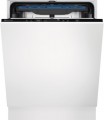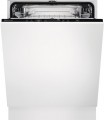Number of place settings
The maximum number of dish sets that can be loaded into the dishwasher at one time. A set is considered a set of dishes for one person: four plates (for the first course, for the second course, salad, bread), a plate for dessert, a cup, a spoon and a fork.
The large capacity allows you to wash numerous dishes in the device at one time without starting the washing programme again. At the same time, excess capacity is just as undesirable as insufficient. Firstly,
a capacious operating chamber affects the dimensions of the entire device. Secondly, such units consume more water. Thirdly, if there is not much dirty dishes, you either have to wait until it accumulates, or start an underloaded device, wasting water and detergents. Therefore, when choosing according to this indicator, real needs must be taken into account and not chase after the maximum capacity.
Water consumption
The amount of water used by the dishwasher in one washing cycle. Usually, it is indicated for a standard cycle — at full load, without pre-rinsing, etc. Accordingly, in special modes, the consumption may differ from the indicated one.
The lower the consumption — it better; this is especially true for those who consume water by metres or who have a limited supply of water (for example, it is drawn from a well with a low productivity). On the other hand, a reduction in consumption can have a negative effect on the quality of the wash. So, choosing an
economical dishwasher, you should pay attention to the washing class (see below). In addition, only models of the same capacity can be compared in terms of consumption — after all, the more dishes, the more water is required to wash them.
Cutlery tray
Separate
cutlery tray for loading (spoons, forks, knives, etc.) into the dishwasher. Such a device is more convenient than a common basket: it allows you to load cutlery separately from the rest of the dishes, while the contents of the tray are compactly located in the “seats” specially designed for this. And the quality of washing is often higher than when using a common basket.
Inverter motor
The presence of
an inverter motor in the design of the dishwasher.
Inverter motors are brushless and have higher efficiency, lower noise levels, and improved safety due to the absence of brushes. However, they are more expensive compared to conventional motors.
Energy class
The energy efficiency class characterizes the the economy of a dishwasher's electricity consumption. Initially, the classes were denoted in Latin letters from A (high degree of economy) to G (high consumption). But later, with the development of energy saving technologies, more advanced classes than A appeared. They are denoted by the letter A with a certain number of pluses (
A+,
A++, etc.); the more benefits, the higher the economy. Most modern built-in dishwashers comply with energy classes from A to
A+++(the last is 30% more economical than the original class A). More high consumption models, such as classes B and C, are much rarer and gradually disappear.
More economical models cost more, but the difference can be recouped in energy savings. Also note that the energy consumption class does not describe efficiency in general, but in comparison with other similar models; therefore, the actual consumption of a small class A device may be lower than that of a large class A++ model.
Country of origin
The country in which the model is manufactured. Despite the fact that most of the capacities are concentrated in China, European factories (
Germany,
Italy,
Poland,
Turkey) for the production of household appliances have not gone away. And certain models can be produced on them. In general, such a division into a Chinese or European factory should not particularly affect the quality of products, but still the stereotype of a reliable European assembly is present in us. However, it is possible that the model may have a country of manufacture, for example, Poland, and in the store under the same article you will meet China.

